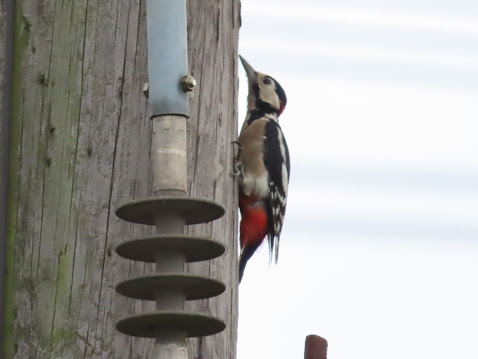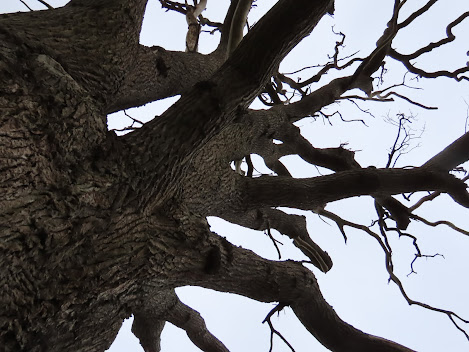GREAT SPOTTED WOODPECKER on a telegraph pole
It now seems that our seasons are melding into each other with nothing telling them apart, except one may be a bit colder or wetter, but not the extremes we had in yesteryear. This year nothing differentiated summer from autumn except the artificial boundaries of our calendars. So July turned to August and nothing changed in the world of The Patch.
View across Second Field to Suffolk Punch Field and the Sentinel beyond
Usually the hottest month of the year, August was dull and grey, full of clouds instead of sun. September briefly baked under a heat haze before joining August and greying out. October was mild but again flushed with plenty of rain. What is a common thread is how similar all these months were, no gradation, no whisper of winter to come.
ROBIN
A feature of this time of year is the FINCH flocks. Both LINNET and GOLDFINCH formed largish flocks, often up to thirty birds, created by post breeding birds that have raised and fledged families on The Patch, the flocks tinckling in the air, with their jerky flight. Smaller numbers of CHAFFINCH and GREENFINCH were present, these two species have had their populations decimated by an avian disease, once common birds that have now declined. On 17/10 a nice male BULLFINCH was present in the Suffolk Punch Field, its melancholy call directing me to its presence.
Some kind of SPIDER
Autumn migration is characterised by the silent movement of WARBLERS, our summer birds moving south through the country. Suffolk Punch Field usually held the main number of these bird, the scattered bushes in permanent pasture proving attractive. When entering the Punch, I waited and watched for the odd twitch of movement that signifies the presence of a bird, warblers are very secretive and can hide in any cover, no matter how small, they are often given away by their call.
The Sentinel of The Patch which keeps guard in The Suffolk Punch Field
CHIFFCHAFFS were the most common warbler, present throughout this period, often forming part of a TIT flock, the large gathering of birds, mainly tits, that form at this time of year. Chiffchaffs are a bird that has bucked the trend and is actually increasing as a species. WHITETHROAT and LESSER WHITETHROAT were common up to mid September when numbers silently petered out. BLACKCAPS were less common, appearing until early October, whilst there was a couple of GARDEN WARBLERS, your typical Little Brown Job, it has no defining characteristics whatsoever.
The Stream dries out in Summer
The Patch isn't particularly good for unusual birds, but there was a female REDTSART in the Suffolk Punch Field on 8/9, an Autumn migrant. The Suffolk Punch Field is always good for migrating SWALLOWS, the permanent pasture proving bountiful for the bugs they feed on. Largest numbers were on 1/9 when 40 were present, but there was a continuous trickle of birds throughout the period.
A beautiful JAY landed in front of me providing great photos of its beautiful wings
The path through Second Field
MAMMALS are not to common on The Patch as the large number of people who use this countryside (its right on the edge of Ipswich) cause too much disturbance. A nice male ROE DEER was seen roaming through the Prairie Field, whilst on 10/9 a FOX was disturbed from The Suffolk Punch Field, it was hidden in the long grass before being flushed.
Slug
An unusual record of a common bird was this large flock of GULLS, on one date. On returning home, I encountered hundreds of this bird flying over the edge of Whitton, this huge flock drifting over the houses. Mainly BLACK HEADS, but also with a few HERRING and LESSER BLACK BACKEDS, they all flew at a certain height, just over house level, lingering for a while before drifting further on over Ipswich. They seemed to be flying in front of a weather front, although what caused them to flock in such a manner I do not know.
Inside Akenham Church
In the nine years I have been visiting The Patch, Akenham church has always been closed, so on the 1/9 it was a surprise to find it open. Nearby footpaths signs point to "Historic Church", a building situated at the top of the Patch, located near to Rise Hall, it holds a few tombstones, some trees and meadowland. After passing the place for such a long time it was definitely worth a visit.
Tractor creating bales of straw
When I approached the church a dog came out and started barking at me, but it was all for show as he picked up a tennis ball and dropped it at my feet wanting me to throw it for him. Opened by a local, its a small church as there are few people living locally, there is only the Hall and a couple of farm buildings nearby. With nothing to really differentiate it from any other church, there is not much to write about. Inside, like outside, there was nothing of note, it was just a very plain, whitewashed building. Its been unused pretty much since the 1970s, which is why its always remained locked.
As always there was the supporting cast of extras on The Patch, those birds that I see every time in the area. A BUZZARD is always present flying round The Suffolk Punch Field, its graceful brown upperparts in contrast to its lighter underwings. Both WOODPECKER species are usually present, each one giving itself away by their loud call, the GREEN by its "yaffel" and the GREAT SPOTTED identified by its "chick" call, very distinct and much appreciated birds.
So the world turns and the seasons arrive and pass, and nature changes to face this cycle. However what has passed for time immemorial may be under threat as seasons become fluid with each other and nothing changes. This is happening too quickly for nature to keep up with, especially in our fragmented countryside where nature lives at the most minimum it can do. The only way to let nature stand up to this threat is by giving large amounts of the countryside over to nature to allow it to breath, rather than confining it to limited nature reserves. Because no matter how good nature reserves are, they are tiny pockets of the countryside, with not enough room to deal with changes. What we need is a landscape dedicated to both nature and food production where we can live in rhythm with nature. Because soon it might be too late and soon we may all play the price.
















No comments:
Post a Comment